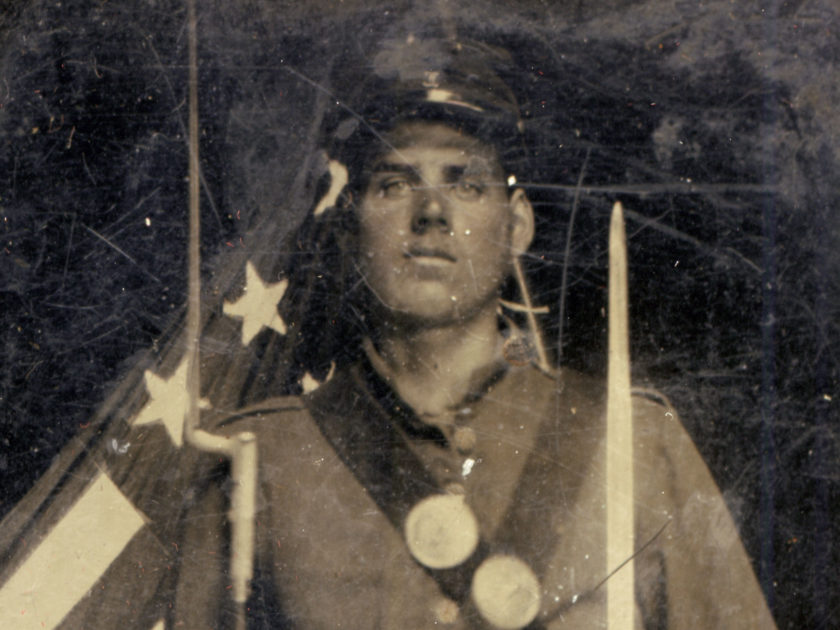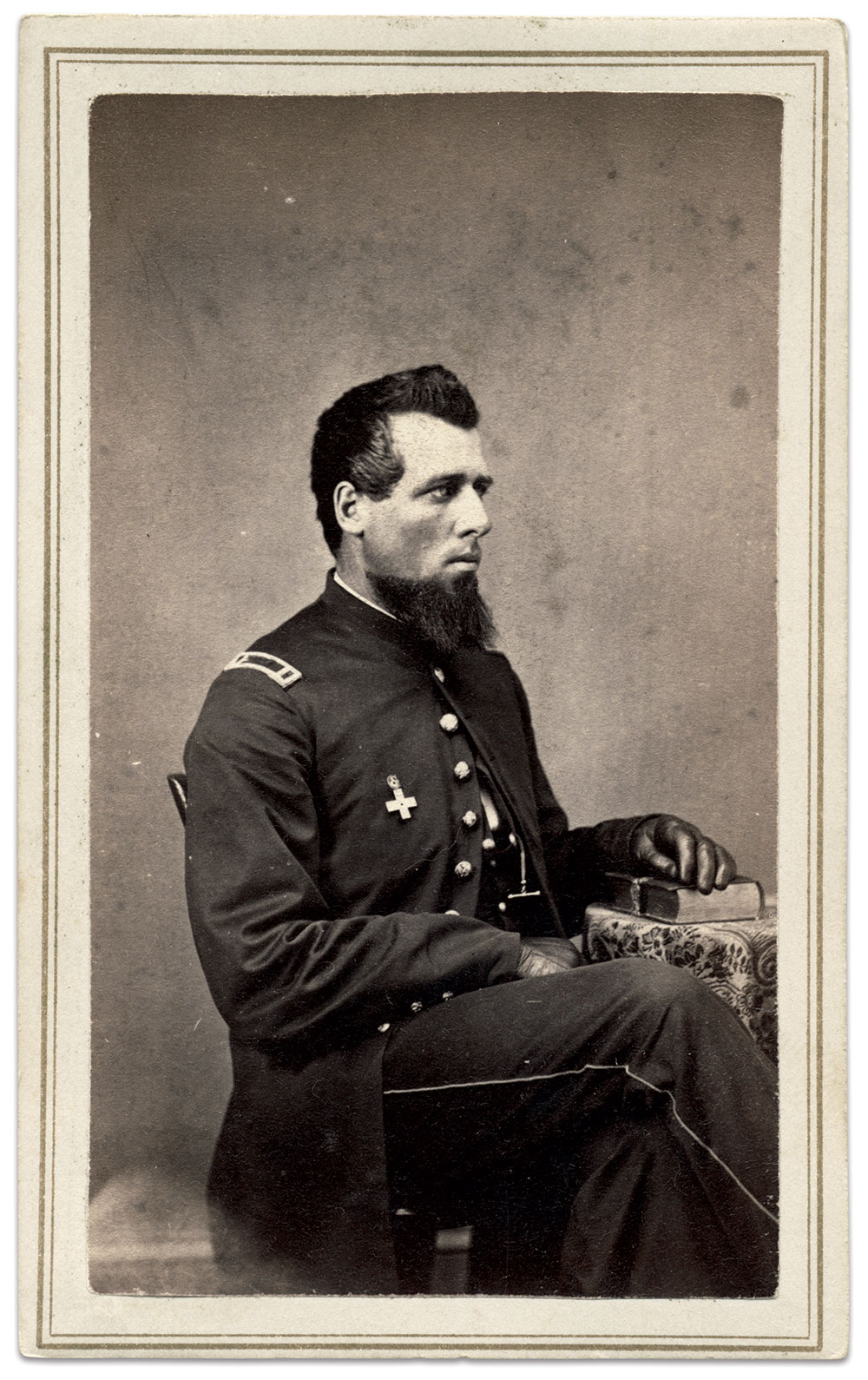
Had a Wrestling Match Decided the Battle…
Odds are George Washington Flagg of the 2nd Infantry would have won it for the federals. The 6-foot temperance man and sergeant was the acknowledged wrestling champ of the Army of the Potomac. According to a biographer, he “knew no difference in men, for he could throw any man he met in five minutes.” During the fight on May 5, a bullet struck Flagg and caused flesh wounds in both hands (note the presence of gloves in this portrait). He soon returned to action and ended the war as a first lieutenant.
Flagg returned to Vermont and became a wrestler. “During his wrestling career, he wrestled no less than 200 matches and after each campaign of travels he returned to work on the farm, never training for a match or a series of matches.”
Flagg died at age 80 in 1919. He outlived a wife and son. His second wife and another son also survived him.

Old Man Aldrich Can Fight
At age 45, the 4th Infantry’s Pvt. John Baxter Aldrich was old enough to be the father of most of the boys fighting in The Wilderness on May 5. A New Hampshire native who had settled in Vermont, he suffered a gunshot wound that splintered his right humerus above the elbow. Four hours later, surgeons performed an amputation in a field hospital.
On or about Nov. 1, 1864, at Vermont’s Sloan General Hospital, the ligatures that secured the stump of his arm were removed. He was encouraged to join the Veteran Reserve Corps, but declined with the explanation that he needed to be with his sick wife. The military decided that Aldrich ought to remain on duty and detailed him as the hospital’s mail carrier until his discharge in August 1865.
His wife survived, and arranged for Aldrich’s funeral and burial after his death in 1887.
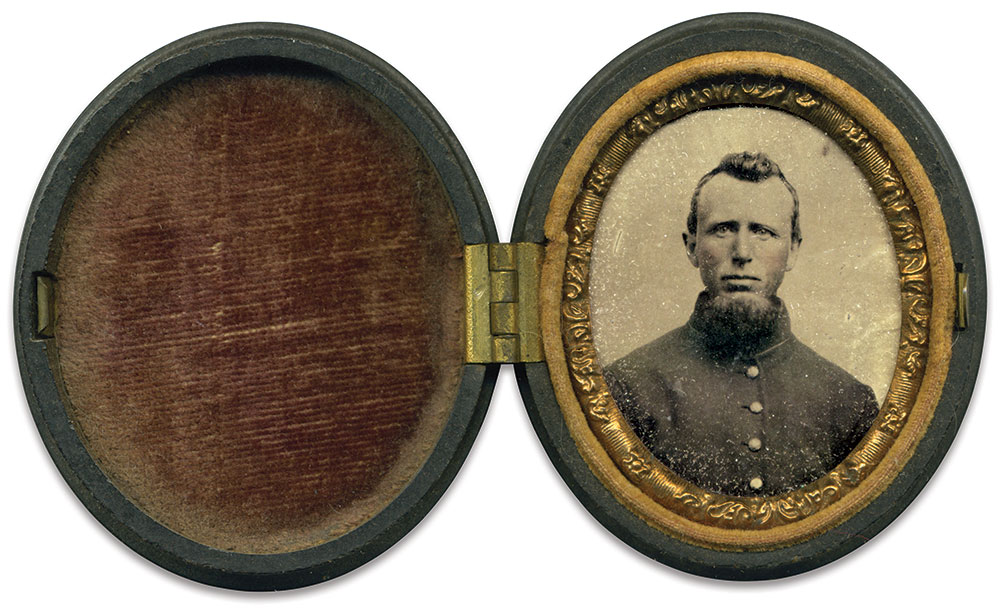
Five Months a Soldier
Though Ezra W. Squires was a latecomer to the 2nd Infantry—December 1863—he proved a good soldier. His service came to an abrupt end when a rifle ball struck him in the head on May 5. The 39-year-old died instantly. He left behind a widow, Maria, and five children ages 2 to 10 years old.
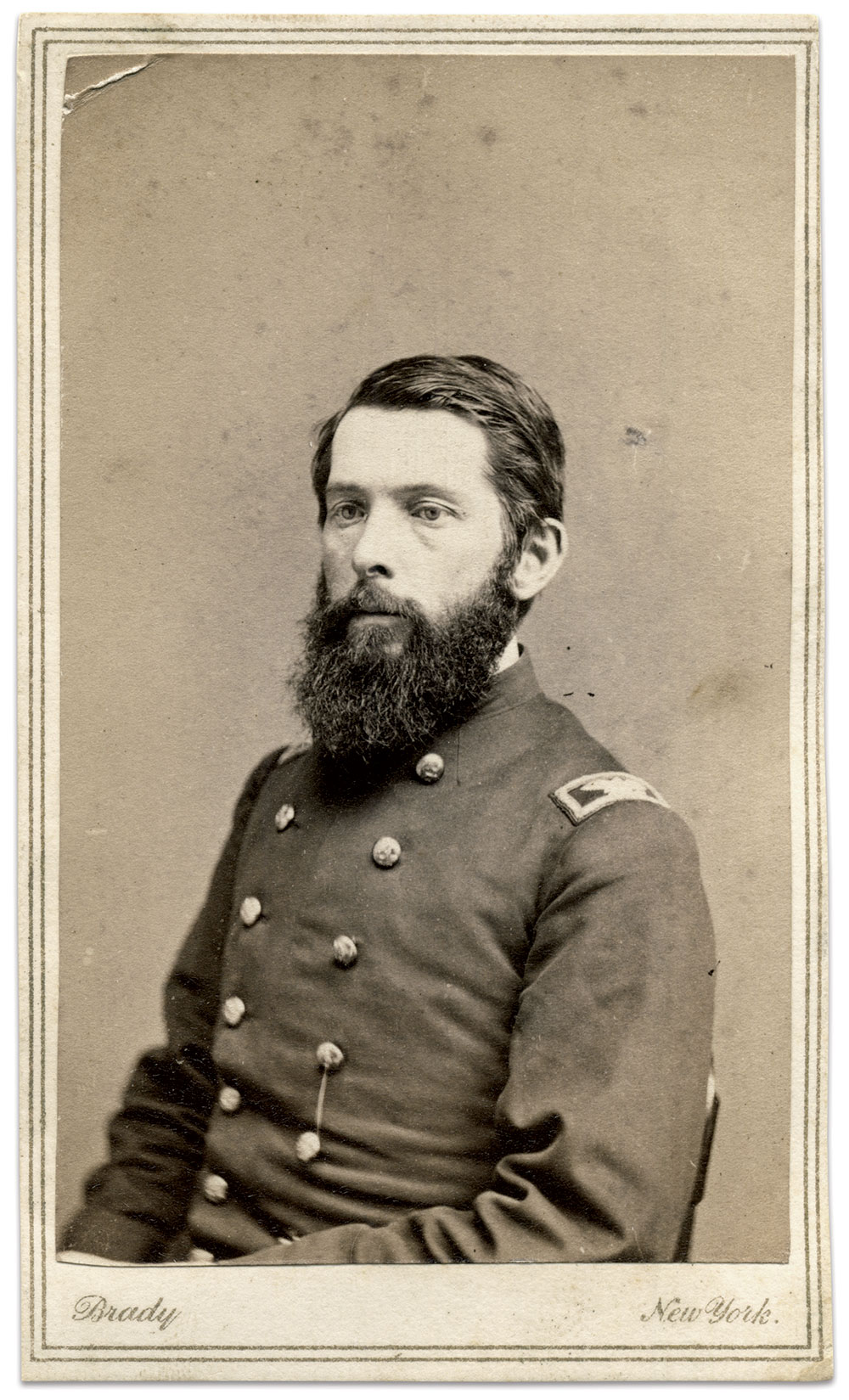
Bright World Above
Any First Vermont Brigade officer standing or mounted on horseback ran a terrible risk in the close fighting during the afternoon of May 5. Many were struck down, including Col. Elisha Leonard Barney of the 6th Infantry. He was hit by a minié bullet in the head near his right temple.
This was his second head wound of the war. The first occurred in 1862 at the Battle of Crampton’s Gap.
Barney was regarded as a model soldier and man. “He breathed a spirit of love and gentleness wherever he went,” noted one writer, who added that he “was greatly beloved by all the subordinate officers and privates of his regiment, and was regarded as a judicious, efficient officer.”
The bullet that hit him in The Wilderness left him insensible. A surgeon removed the ball 24 hours later. Following the surgery, he immediately came to his senses, asked his adjutant if his wife had been notified, and expressed hope that he would recover and see her again.
It was not to be. He succumbed to his wound on May 10. Barney was 32. His widowed wife may have taken comfort in the last letter he wrote before the battle. “It may be my lot to fall in this campaign; but I thank God that Christ has died for me, and if I am never again permitted to return to my home and those I love, I believe we shall meet in that bright world above.”
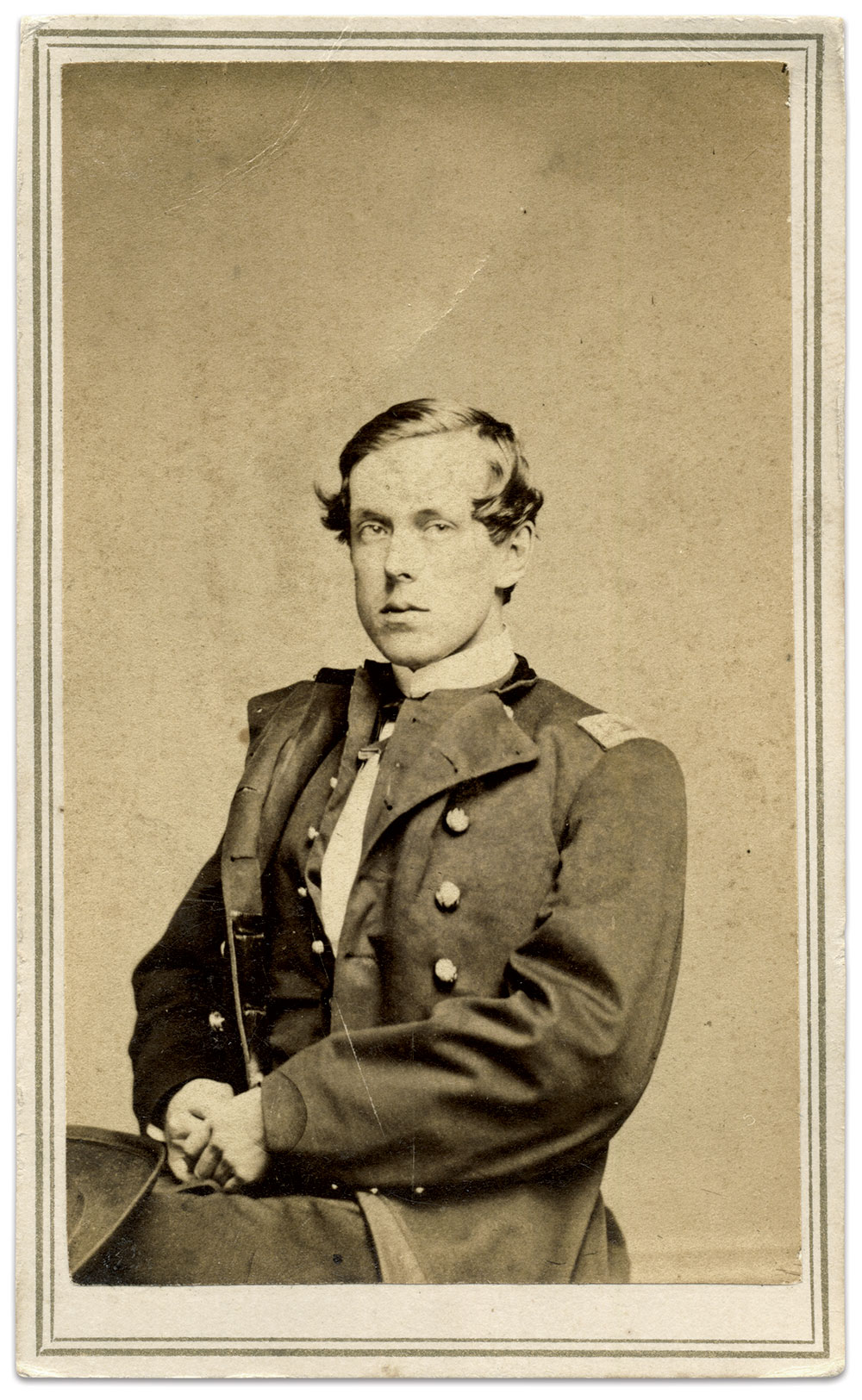
In Command for Less than an Hour
John Steele Tyler, the 21-year-old lieutenant colonel of the 2nd Infantry, assumed command of the regiment after a minié bullet instantly killed Col. Newton Stone as he rallied his men.
The men held Tyler, a reverend’s son, in high regard. One biographer noted that he was “a boy in years, but a man in heroic thought and deed.”
Less than an hour after he took command, rebel lead struck Tyler in the thigh. “He expected it would be mortal, but forbade his men to leave the ranks to attend to him, cheering them on against the enemy,” stated his biographer.
After being considerably weakened by the loss of blood that filled his boot, he consented to be carried off the field. Taken to New York City, a civilian physician operated on Tyler and found that a small ball, possibly a buckshot, had nicked the femoral artery. Tyler succumbed to its effects on May 22. Less than a month later, on June 9, the governor of Vermont formally commissioned him colonel of the regiment.
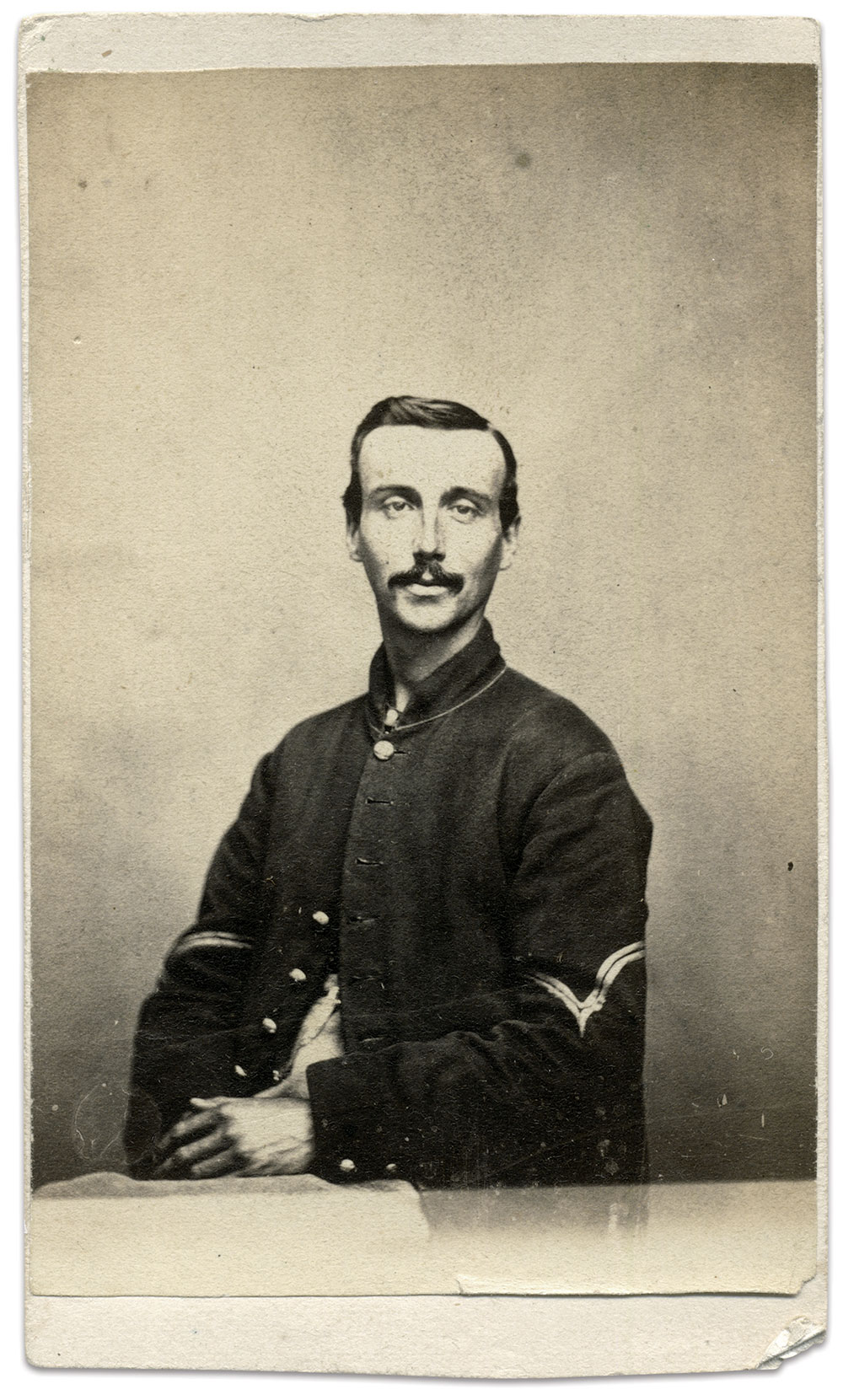
Fatal Charge on the Plank Road
Cpl. George C. Bliss and his comrades in Company H of the 6th Infantry charged enemy works near the Orange Plank Road in a hail of lead on May 5. One bullet struck Bliss in his left leg, a wound described as severe, though it did not break bone.
Bliss was eventually transported to a hospital in Alexandria, Va. He lingered there until July 20, when he succumbed to its effects. Bliss was 23 and unmarried. His remains rest in plot 2443 of the Alexandria National Cemetery.

No Stranger to Battle Injuries
In the 2nd Infantry on May 5, bullets wounded many in the upper body. Cpl. Myron E. Hubbard of Company I was no exception. The ball that hit him in the left shoulder fractured his scapula. The 20-year-old was no stranger to battlefield injuries. Almost exactly a year earlier at Chancellorsville, he was slightly wounded, the location of which was not reported. But his Wilderness wound was more serious. He spent a few months in the hospital before returning to the 2nd, and mustered out with his surviving comrades in July 1865. The last time his name appeared on a record was 1929.
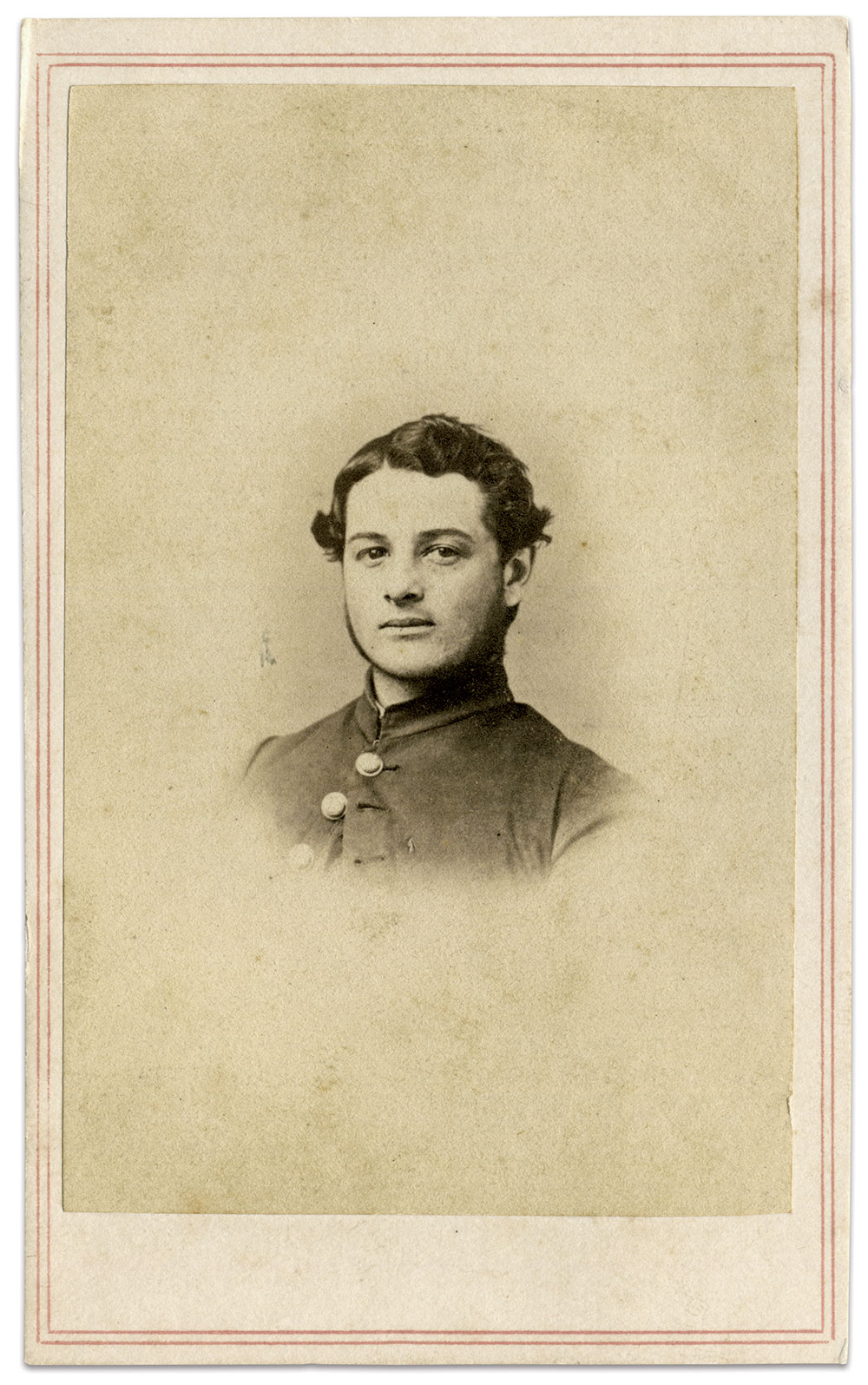
Trial Under Fire
A review of Gilbert H. Porter’s military records suggests a problem soldier. The end of his first year in the 5th Infantry coincided with the battles of Crampton’s Gap and Antietam, during which time he was charged with neglect for losing his musket and equipment. In 1863, soon after Gettysburg, he was sent to Lovell General Hospital in Portsmouth Grove, R.I., where a number of patients were Union soldiers convicted by court martial.
He remained there until Jan. 25, 1864, when he disappeared. He was found and sent back to his company. Orders issued on March 19 stated that Porter be returned to duty subject to trial by regimental authorities.
No evidence exists that this occurred before his death in action on May 5.

15-Year-Old in the Ranks
Once the 3rd Infantry went into action on May 5, the men began loading and firing their weapons. In Company I, 15-year-old Pvt. Nahum Eugene Harvey squeezed the trigger of his musket and sent Yankee lead flying. He reloaded and fired again. But before he could get in a third shot, a minié bullet struck his arm and broke a bone.
Two months later, he was not healed. “My elbow joint is stiff and my arm is a little crooked,” he wrote from his convalescence. The surgeon “says that he thinks that there is some pieces of bone going to work out.”
While he was away from the regiment, two other members of his family joined the casualty list at the Battle of Spotsylvania. His father, George, was struck in the chest by a bullet and died without a final word. An older brother, Milo, was hit in the forearm by what was believed to be friendly fire. He survived the wound and eventually returned to the regiment.
Young Harvey rejoined his comrades and suffered a second wound at Petersburg after a spent musket ball hit him in the knee.
Harvey mustered out in July 1865 and returned to Vermont. He lived until 1930. His wife, Rachel, survived him.
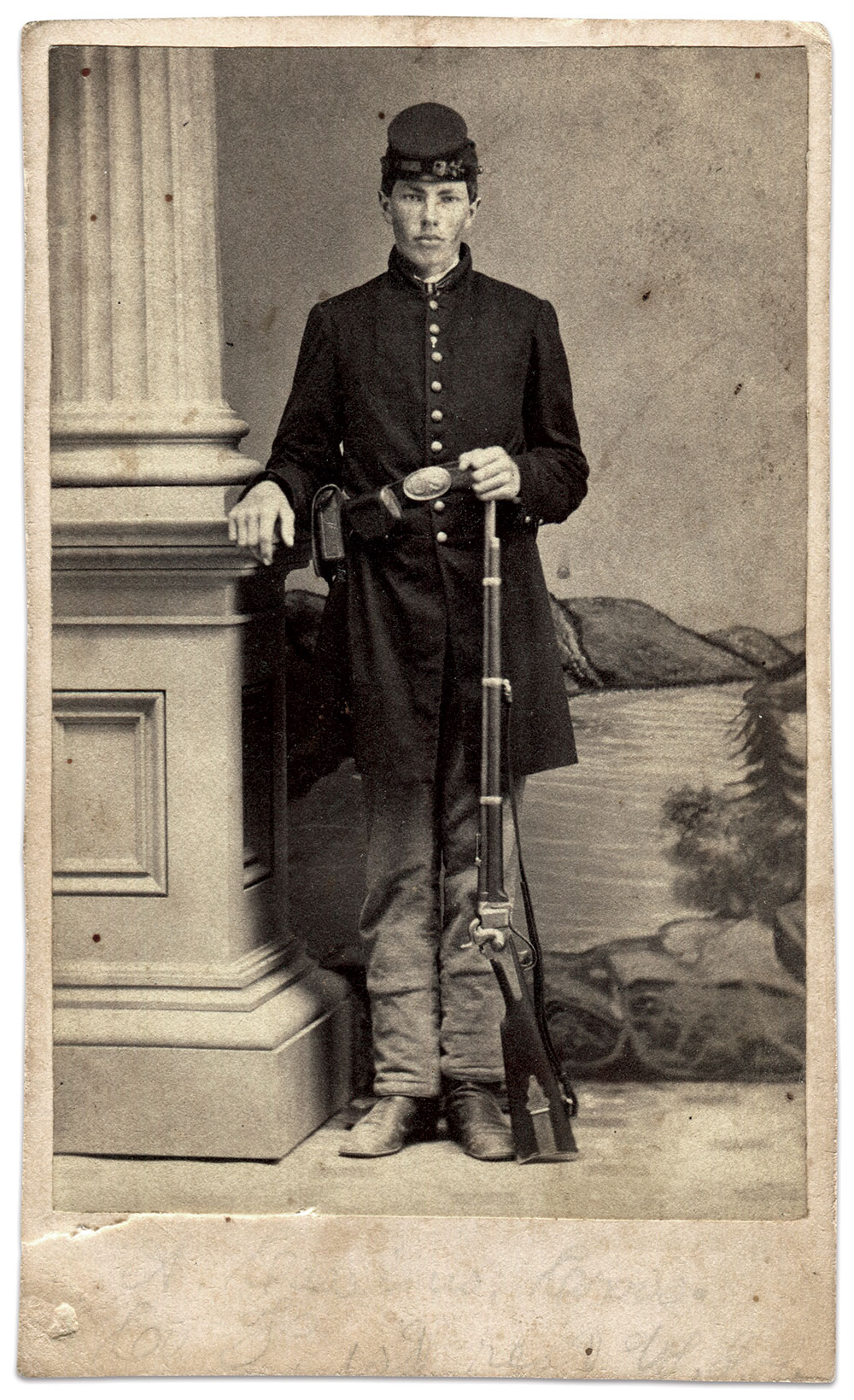
“Noble Boy Having Died for Others”
The 1st U.S. Sharpshooters arrived on the battlefield during the afternoon of May 5 and promptly deployed in a skirmish line. In its ranks was 18-year-old Artemas Cassius Cross, the son of a farmer in Waltham, Vt. He had enlisted in the autumn of 1862, and likely stood with his Sharpe’s rifle for the portrait pictured here about this time.
In The Wilderness, the skirmish line was ordered forward to ascertain the enemy’s position and soon found it. “It was a hot reception for the boys, but they endeavored to pay it back as earnestly,” stated the regimental history, which added, they “suffered considerable loss in a few moments.”
When the casualty list was compiled, the dead included Cross. His remains were buried in the vicinity of the battlefield, and later reinterred at the national cemetery in Fredericksburg, Va. His grieving family back home erected a cenotaph in his memory in Waltham. Etched upon the stone: “Noble boy having died for others. Rest in Him.”
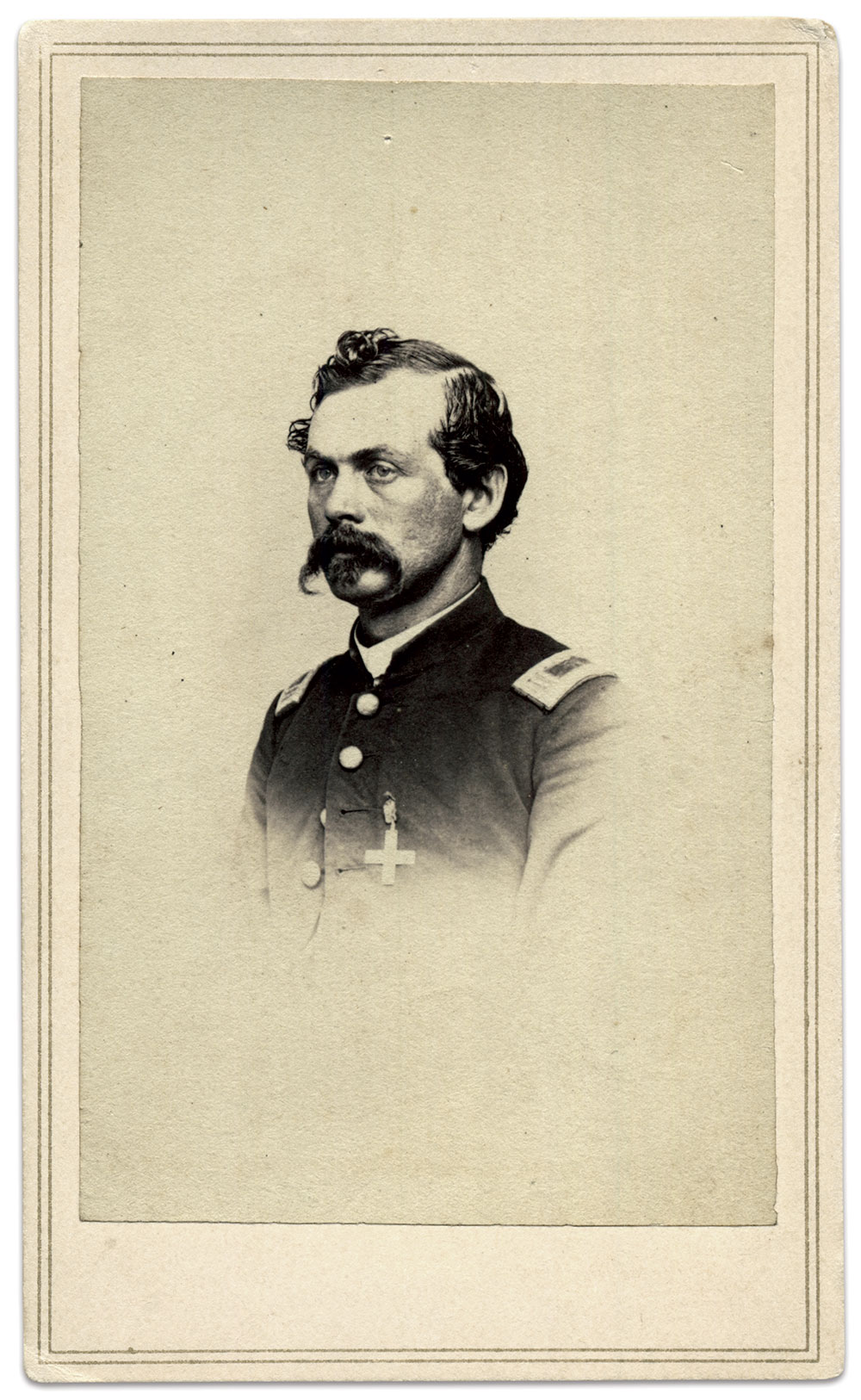
Pure Patriotism
In the midst of the fighting on May 5, a bullet tore into Capt. William H. Cady’s left hand. He retired just long enough to have the injury dressed, and then returned to his men in Company A.
Cady had enlisted in 1861. The men of his company elected him second lieutenant after the first man voted into the position resigned. Cady, noted the biographer, “would have gallantly shouldered his musket and trudged along to do a soldiers’ duty in whatever place he was assigned. It was pure patriotism that sent this man to the field.”
Cady proved a capable officer, rising through the ranks to captain. He fought in all the major engagements with the regiment, suffering his only wound at The Wilderness. He returned to Vermont after the war and became a lieutenant colonel in the state militia. He was also the proprietor of Stark House, a hotel in Bennington.
He died in 1879 after a brief illness attributed to complications of Bright’s Disease, a liver ailment. He was 43. His wife and two children survived him.
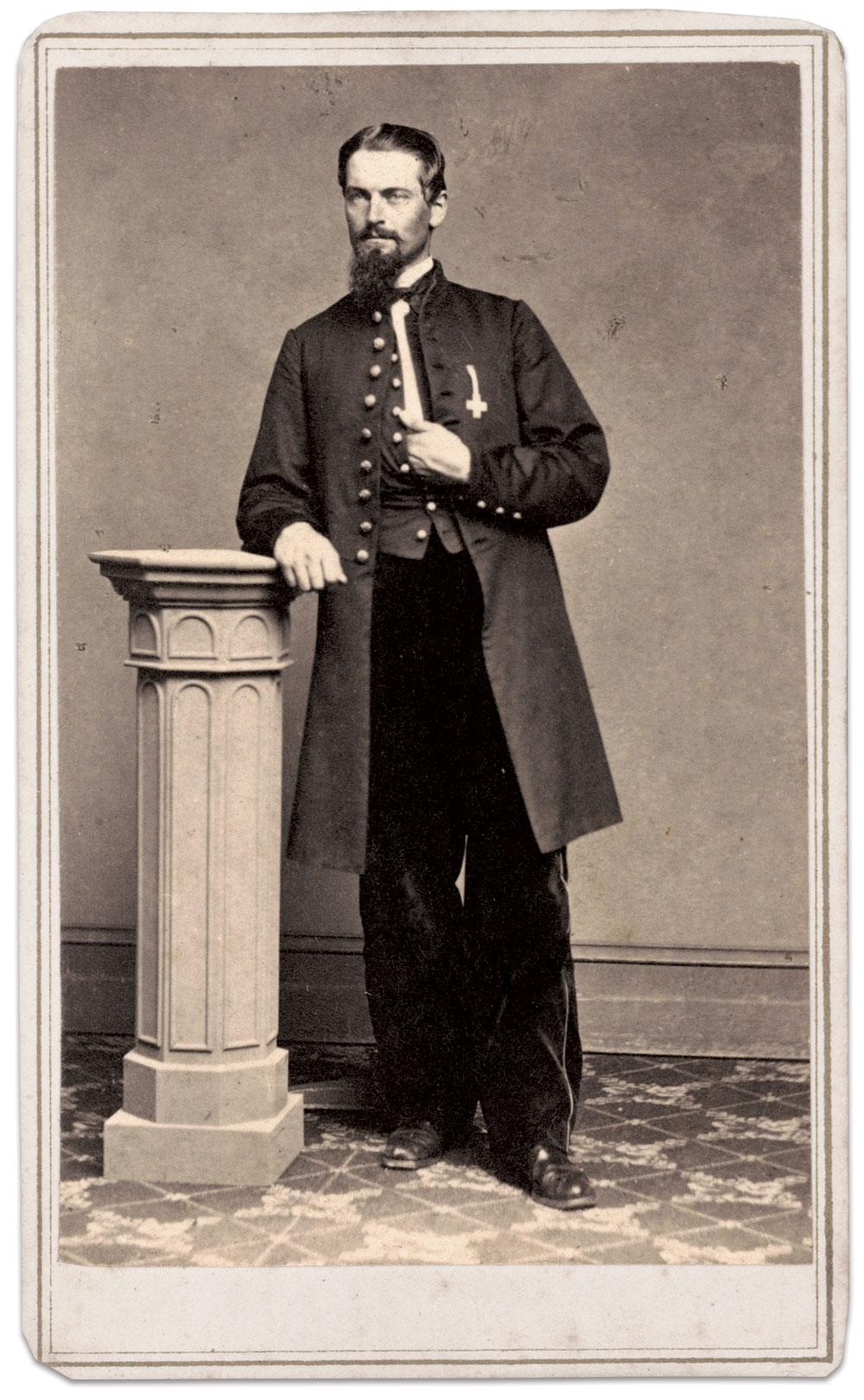
“Killed by Our Own Men”
This headline appeared in a Vermont newspaper story that announced the death of 1st Lt. Thomas Ensworth. A railroad brakeman prior to the war, he had joined the 4th Infantry as a first sergeant and was promoted through the ranks in recognition of his bravery and other leadership qualities. Always present for duty, he participated in every major fight with his comrades, and escaped them all without injury. His luck ran out in The Wilderness on May 5, when Union artillery firing behind him came up short. A spent ball struck Ensworth in the back. Carried to Chancellorsville, he lingered until May 8. Others were also hit, but it appears Ensworth was the only fatality from this friendly fire. His military service record does not state the cause of his death. But where the military was not able to go the press did.
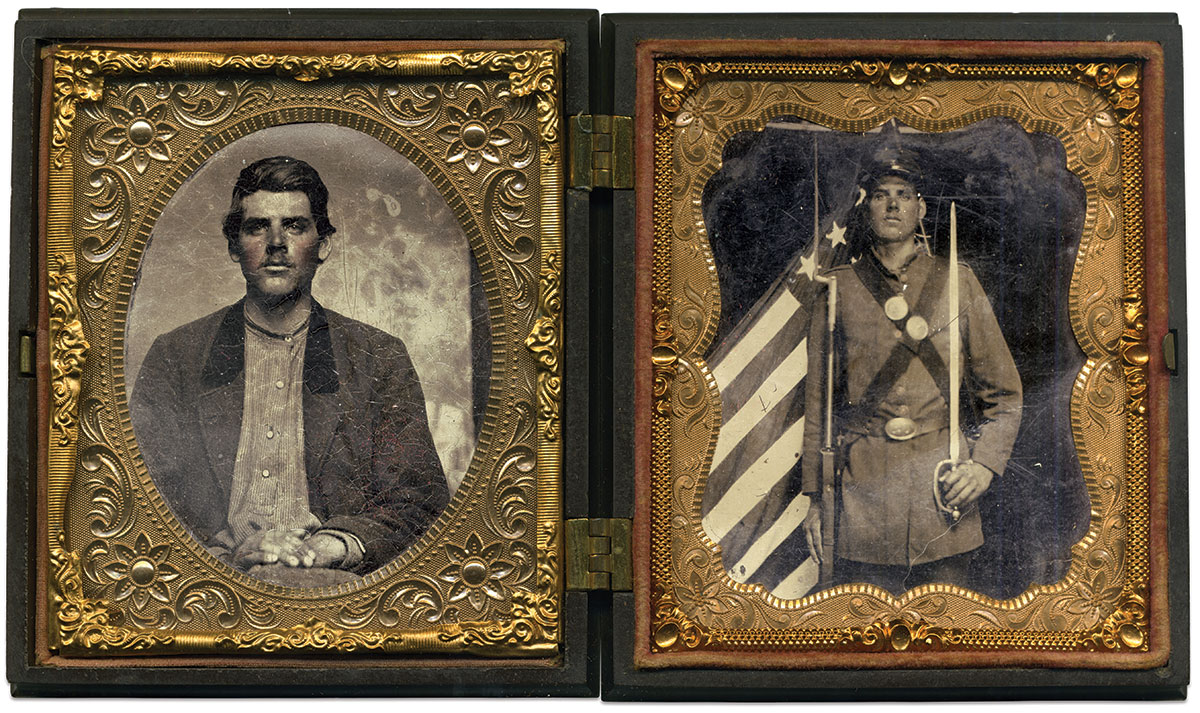
Vengeance Bullet
The minié bullet that struck Sgt. Charles Henry Newton of the 4th Infantry in his left side ripped through his body with a vengeance. The bullet tore into his rib cage at the ninth and tenth ribs, and then passed down and back through his vitals before exiting near his last lumbar vertebrae.
The possibilities of infection from clothing and bits of nature pushed into his body might have proved fatal. But somehow, he pulled through and made a full recovery.
Four months later, he returned to his comrades and was assigned to lighter duties as quartermaster sergeant. He ended his service in July 1865 as a first lieutenant.
Newton returned to Vermont, married and eventually settled in North Dakota. He died at age 82 in 1923. His wife, Prudence, predeceased him, and a daughter survived him.
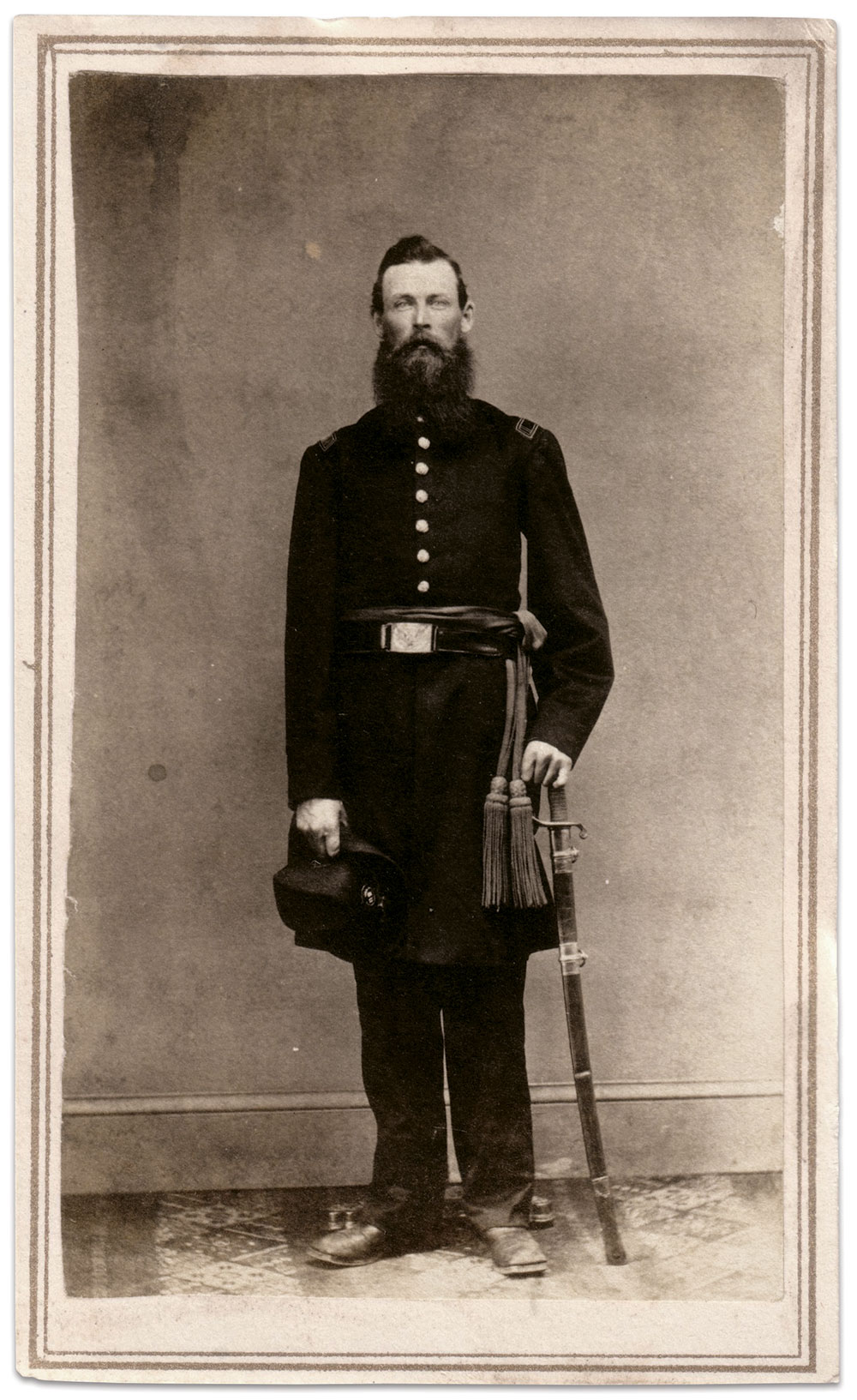
The “Corner Where Death Awaited All”
First Lt. Henry Edwin Kinsman and his comrades in the 1st U.S. Sharpshooters rushed down the Orange Road on the morning of May 7, with orders to capture an enemy battery. They deployed into thick woods and closed in on the rebels.

Connecticut-born Kinsman, a Vermont resident and gunsmith by trade, had started the war in the 1st Connecticut Infantry for a 3-month enlistment. He then joined the 1st.
In The Wilderness, he found himself in a hopeless situation. “We were subjected to a severe fire of cannon and musketry,” recounted the regiment’s historian. “The enemy had us in a bad spot—a complete corner where death awaited all.” Many were hit, including Kinsman. The exact nature of his wound is unknown. He survived and mustered out before the end of the year.
Back in Vermont, he became a machinist at Pratt & Whitney Co. He died in 1905 at age 72. His wife and three children survived him. History remembers him for the Battle of Antietam, where his name was engraved on a stone sentinel in honor of his company’s service.
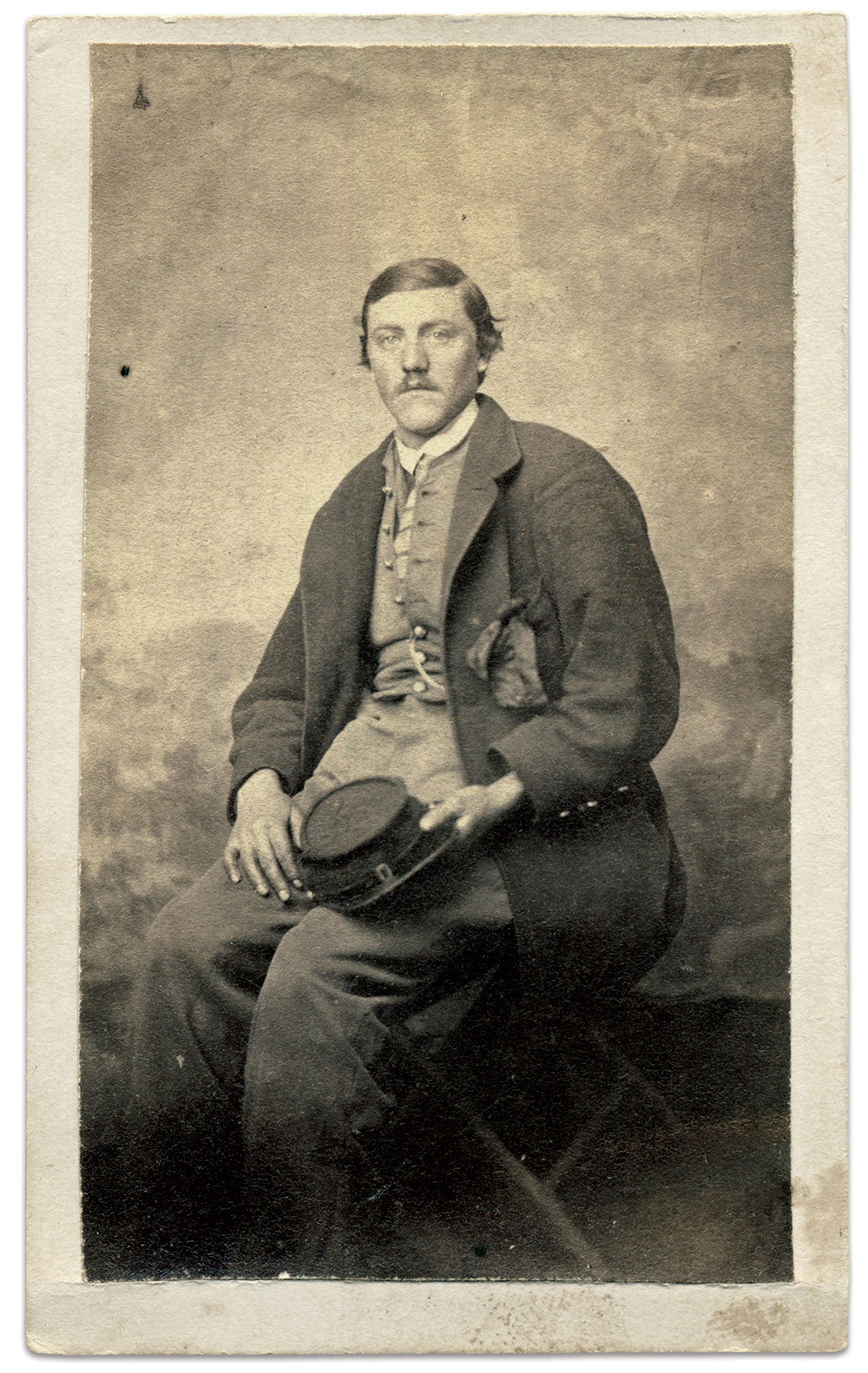
“My Country Called and I Obeyed”
The first casualty lists reported in Vermont newspapers noted that Pvt. Myron C. Chapman of the 4th Infantry had suffered a wound during the fighting on May 5. His military service record indicates that he was killed in action that day. A cenotaph erected for the 19-year-old soldier in his home village of Grafton, Vt., states that he was, in fact, wounded on May 5 but died on May 7. It adds that he was buried near Salem Church, Va. It was his second wounding of the war. His first, at Fredericksburg, appears to have been a minor injury.
Simple words running along the tip of the cenotaph speak to the life of a good soldier who served with little fanfare in the ranks: “My Country Called and I Obeyed.”
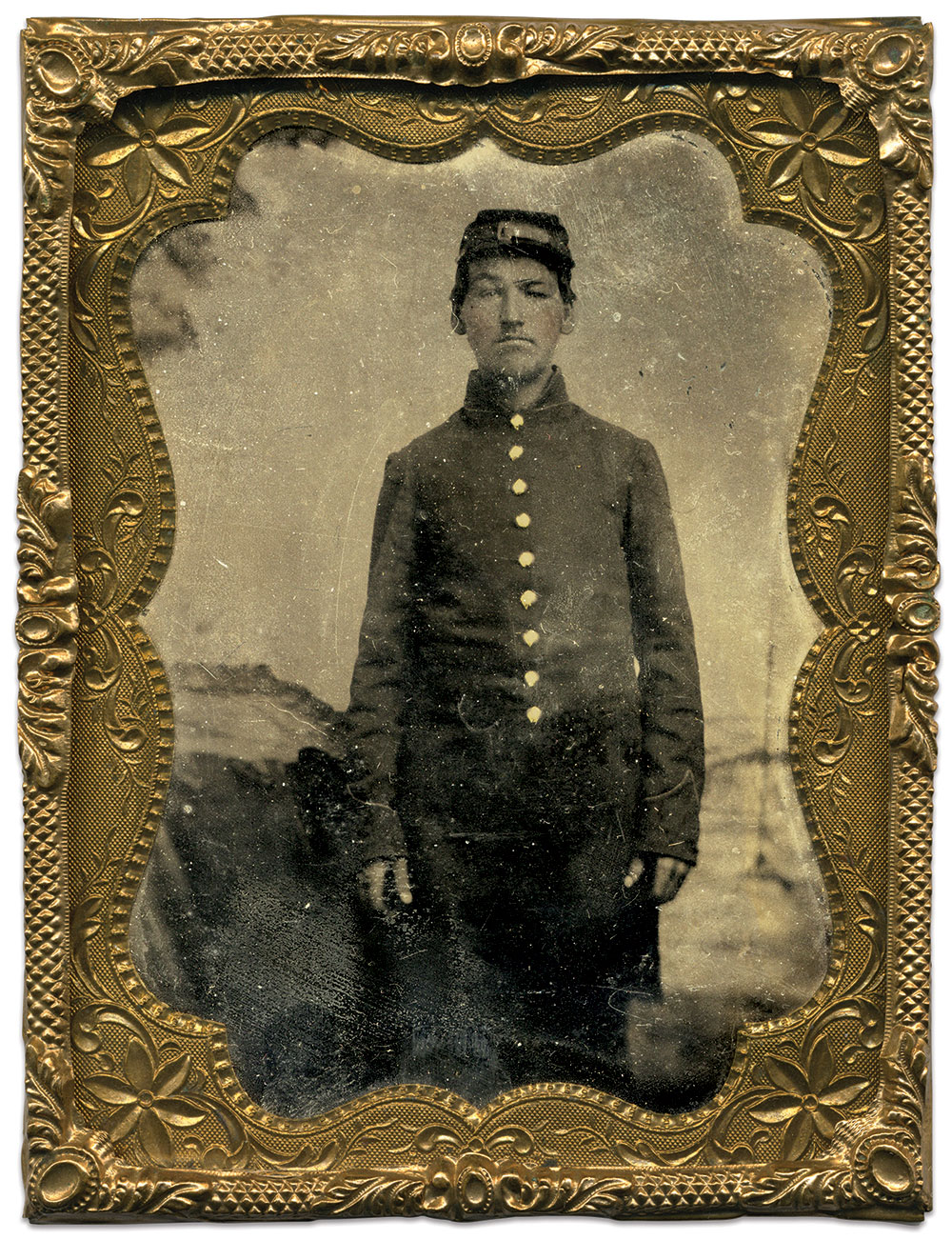
Never Heard from Again
Erastus B. Felcher, a private in Company A of the 3rd Infantry, marched into The Wilderness on May 5—his first major engagement as a soldier. The only surviving son of a widowed deacon, he had been drafted less than a year earlier, and exchanged his farmer’s pitchfork for a musket. In October 1863, he was assigned to the 3rd and sent to the South to join his command.
His tenure was brief. At some point during the action on the first day’s fight, he went missing in action. He was initially reported as a prisoner of war, which suggests that one of his comrades might have seen him fall into enemy hands. But he did not show up on any subsequent records, and likely perished soon after he faced his first hostile fire. He was 26.
A cenotaph located in a Bakersfield, Vt., cemetery honors his memory.
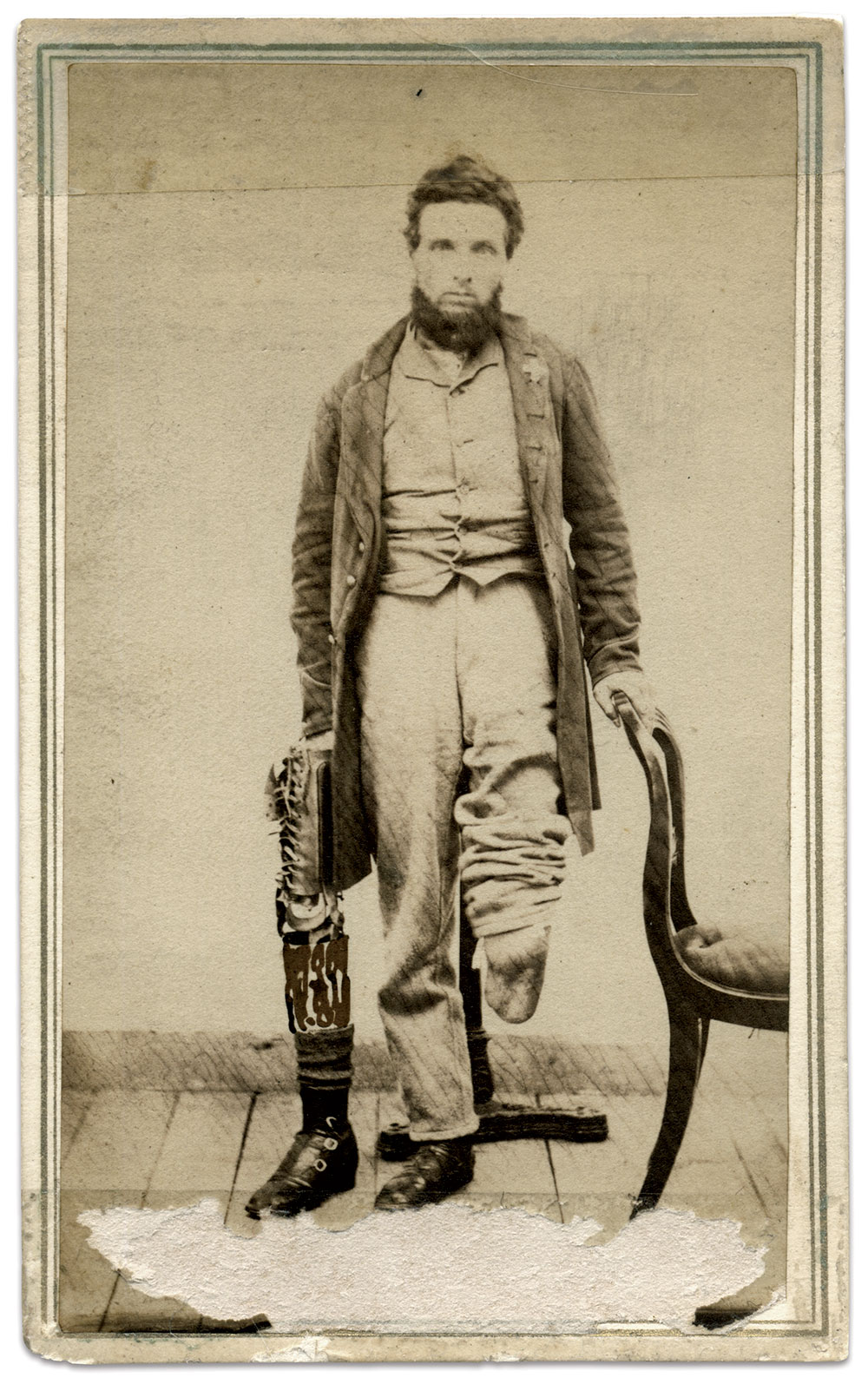
Bly’s Leg
About six hours after John McGowen fell with a gunshot wound that fractured both bones above his left ankle, a surgeon treated the mangled leg on the battlefield with chloroform and a saw.
McGowen, an Irish immigrant, had enlisted in 1861. During three years of service, his record was spotless.
Sent to Vermont, his stump healed without incident. His standard-issue artificial leg however, did not fit well and could not be altered. In July 1865, he was sent to New York City to be fitted with a state-of-the-art prosthetic device patented by physician Douglas Bly. His design was reportedly superior to standard models.
A note on the back of his photo states that two weeks after he received the Bly leg, “stump very tender and he is unable to walk on his artificial leg any great distance.”
McGowen got around, by artificial leg or crutches, until 1902, when his decomposed body was discovered near a dock at Port Henry, N.Y. His death was ruled accidental. According to his family, he had been between jobs as a wagon driver. His mother and 11 brothers and sisters survived him.
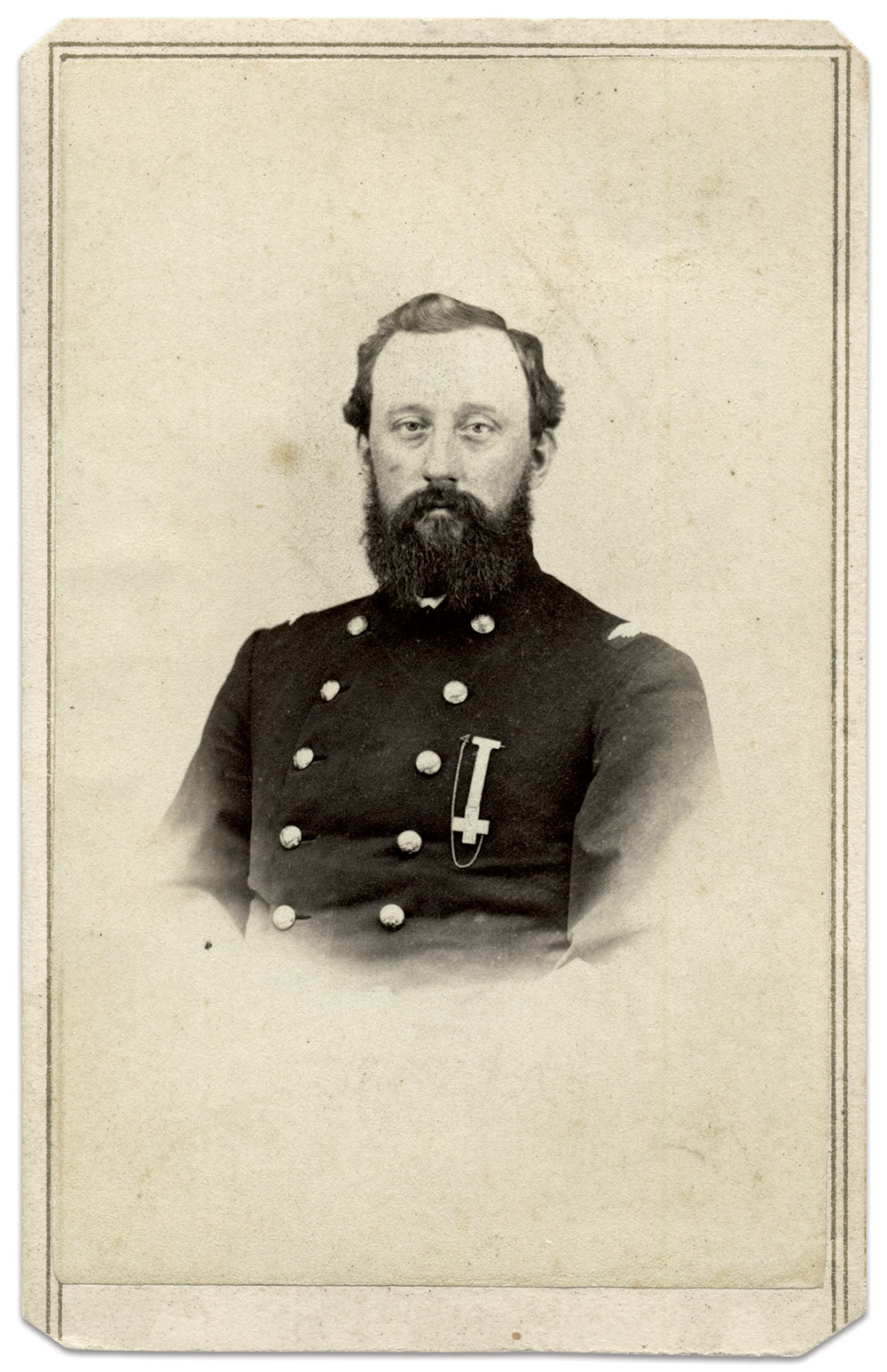
The Gallant Giant
The torrents of rebel lead that wreaked havoc on Vermont’s regimental commanders did not spare Col. George Perkins Foster of the 4th Infantry. The handsome 6-footer suffered a bullet in his left thigh, which forced him to relinquish command.
The injury deprived the regiment of a popular officer and one of its best fighters. “Like most men of unusual physical power, he was one of the kindest and most genial of men; his good nature never failed him,” noted one writer. “In war or in peace, in peril or out of it, he was always the same cool, imperturbable man, always good-natured and always gallant. Underneath his bland exterior he concealed a deal of sagacity, sly humor and resolution.”
Foster started his service as captain of Company G and worked his way to colonel just a few months before The Wilderness. He made a full recovery from his wound and went on to command the Vermont Brigade. He received the brevet rank of brigadier general for his leadership.
After the war, he served as a U.S. Marshal and, in 1870, notably arrested Fenian Gen. John O’Neill for violating federal neutrality acts.
Foster died of diabetes in 1879 at age 43. His wife and three young children survived him.
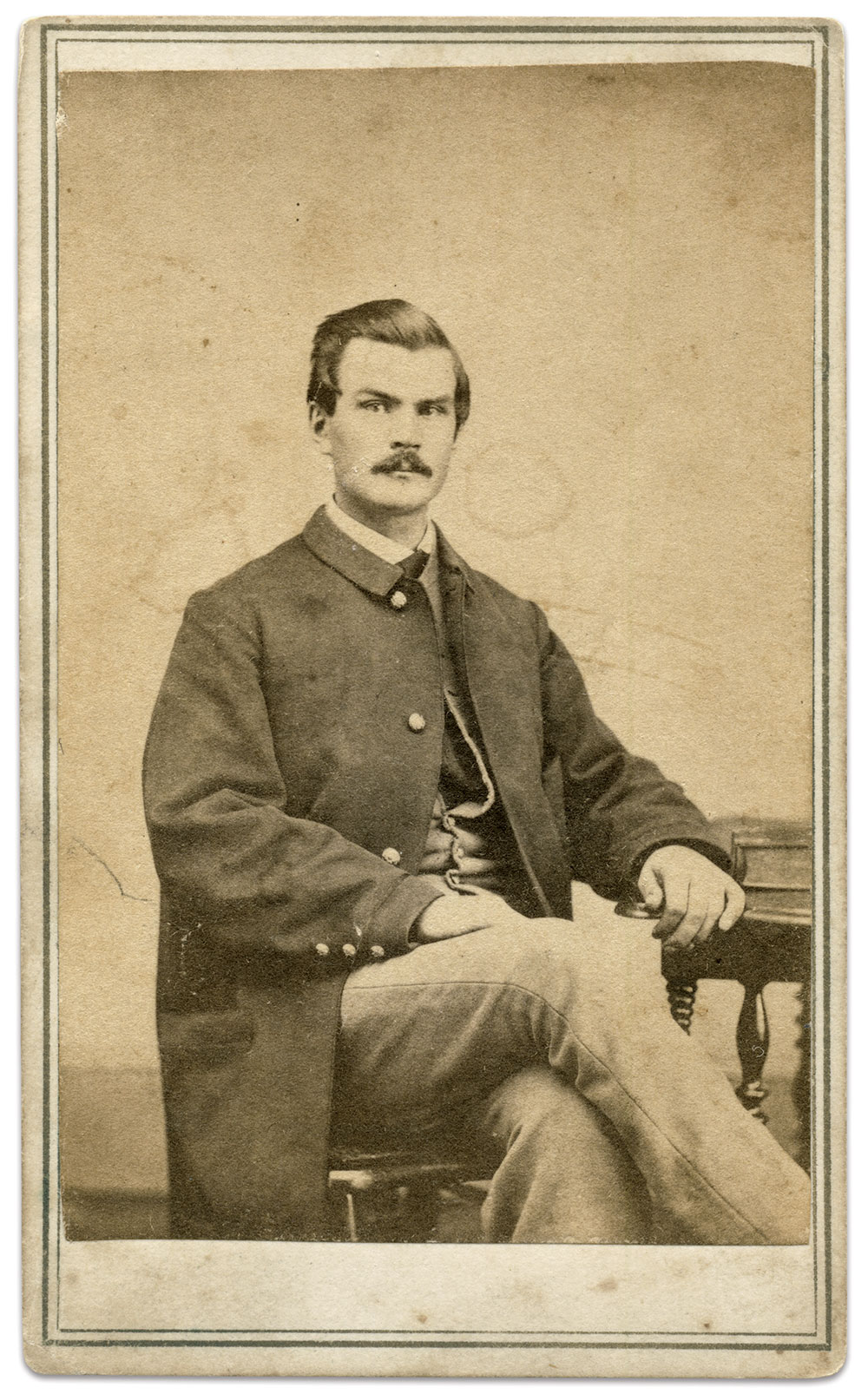
Retaking an Abandoned Gun
A musket ball struck Private Arthur E. Stockwell of the 2nd U.S. Sharpshooters in the head on May 5. Though the exact moment went unrecorded, it most likely occurred during his regiment’s only major action of the day. That evening, Col. Hiram Berdan ordered a section of the 2nd to retake a cannon captured by the rebels earlier in the fight. Stockwell’s captain led the effort. According to the regimental historian, the officer “and plenty of men, rushed down fighting their way, and not only brought off the gun but took as well the harness of the dead horses, bringing it along.”
Stockwell’s Wilderness wound was his second of the war. He suffered his first at Antietam when a shell fragment hit him in the arm. In both cases, his recovery was relatively quick and he soon was back in action.
In early 1865, he transferred to the 4th Infantry and mustered out with his sergeant’s stripes at the end of the war. He returned to his home in Stowe, Vt., where he died in 1880 at about age 41.

“I am a Dead Man”
Capt. Elijah J. Wales had extended his arm, raised his sword and beckoned his men in Company C to move forward when a minié bullet tore into his left side. The projectile ripped through his chest and right lung before it exited his back. According to one account, “As he dropped to the ground he exclaimed, ‘I am a dead man.’” Left on the field with other wounded, the surgeon of the regiment passed him by again and again, attending to more critical cases. Some time during the night, Wales pulled himself up and walked miles through unknown countryside, his arms so useless that he was unable to bring a canteen to his lips. Through sheer determination, he made it to a field hospital.
Never one to miss a fight—he participated in 26 engagements during his four years with the regiment—he healed quickly and soon was back in action. A few months later, on Aug. 21, 1864, he suffered his second war wound while on reconnaissance in the Shenandoah Valley.
“While looking over the ground with a field glass a bullet struck him above the left eye, splintering the bone, glanced off and struck a man behind him, killing him instantly,” noted a biographer.
Wales suffered two more wounds before he left the army in 1865 with a brevet rank of major for his actions in The Wilderness. He returned to Vermont, and resumed his job as a mechanic. He lived until 1890. The initial cause of death was typhoid fever, but an autopsy revealed that he succumbed to complications from his Wilderness injury. His wife, Sophia, and three children survived him.
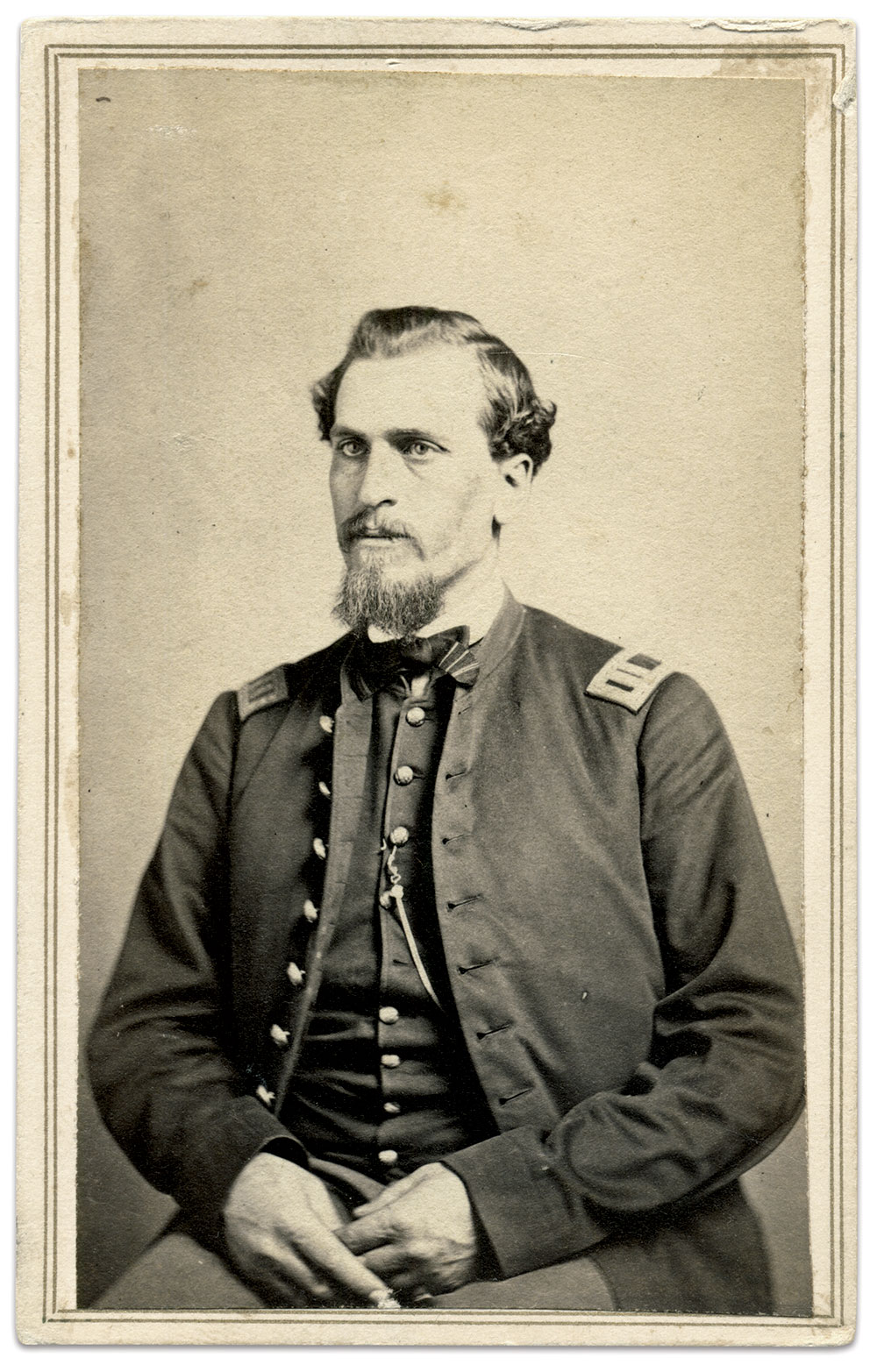
Deadline Road
There came a moment late on May 5 when rebel troops swung around the left flank of the 2nd Infantry, which had put up a stubborn fight. The regiment’s lieutenant colonel, aware of the danger, ordered Capt. Daniel Stearns White of Company I and 16 men to cross a road and deploy.
For White, who had served briefly in the regular army before hostilities began in 1861, the Civil War was surreal.
“I never dreamed of a war among ourselves or that I would ever witness a battle or much less participate in one,” he wrote to his wife before the battle. “We see by this how short sighted we are and how little we know of the future or the manner in which we may be affected by it and it is well we do not.”
White and a company corporal, Albert Abraham May, formed the men and took off. They ran into a hail of fire. A musket ball hit May in the lower right leg just as he crossed the road and he tumbled to the ground. The bullet fractured his tibia.

Nobody else made it across.
A shot struck White in the right leg just below the knee. Both men were eventually treated and hospitalized.
May spent several months as a patient, returned to Company I, and served through the rest of the war. Back in Vermont, he eventually started a successful business college. He died in 1919, a victim of the flu pandemic in the wake of World War I.
White nearly bled to death. He left the regiment in October 1864, returned to Vermont, and became successful in the lumber and furniture business. He later moved to the Midwest and became much better known for “Dr. White’s New Hair Grower,” a patent medicine. He lived until 1912.
SPREAD THE WORD: We encourage you to share this story on social media and elsewhere to educate and raise awareness. If you wish to use any image on this page for another purpose, please request permission.
LEARN MORE about Military Images, America’s only magazine dedicated to showcasing, interpreting and preserving Civil War portrait photography.
VISIT OUR STORE to subscribe, renew a subscription, and more.

